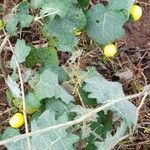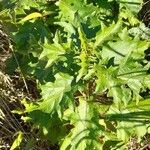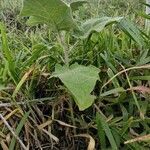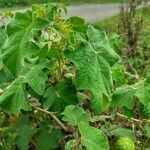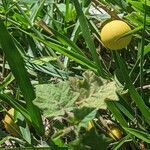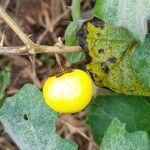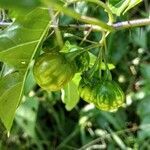Straggling, short-lived, perennial herbs or subshrubs, 1-2 m high. Stems much branched at and above base; stems, petioles, pedicels and leaves densely glandular-puberulent with ± uniform, multicelled, straight, simple hairs less than 0.5 mm long, some hairs eglandular; stem prickles few, most with thickened and flattened bases and conspicuously recurved, up to 6 mm long. Leaves solitary or in pairs, membranous, blades broadly ovate to ovate-triangular, base subcordate, 80-150 x 50-150 mm, sinuate-lobed up to 1/3 of way to midrib, lobes 4-6, subobtuse or subacute, lower surface also with 4 or 5-rayed stellate hairs, rays nearly always in one plane, one ray longer than rest, up to 0.5 mm long; armed on midrib and minor veins with straight, acicular, laterally compressed, broad-based, whitish to yellowish prickles up to 20 mm long; petioles 20-90 mm long, armed with similar prickles. Inflorescences axillary, 4-or 5-flowered; peduncles stout, 15-20 mm long. Calyx pubescent on outside, 4-7 mm long, 5-lobed to about middle; lobes triangular-ovate, enlarging and concealing immature fruit, then prickly on outside. Corolla white or greenish, 15-27 mm diam., deeply stellately 5-lobed; lobes broadly lanceolate, 8-12 mm long, recurved, apex acute to mucronate, outer surface pubescent with glandular and eglandular hairs. Stamens white to cream; filaments ± 1 mm long; anthers linear-lanceolate, attenuate, 8-10 mm long, pores minute. Ovary globose, densely and minutely puberulent: stigma capitate. Fruit globose, 15-30 mm diam. when mature, minutely puberulent when young, later smooth and glabrous, immature fruit pale and dark green with white mottling, yellow at maturity with leathery skin surrounding thin-layered, pale green, mucilaginous, scented pulp. Seeds numerous, 190-385, moderately compressed, suborbicular, ±2 mm long, lacking marginal wing, surface reddish brown, very minutely rugulose, seed coat closely investing the endosperm.
More
Herbs or subshrubs, erect, 0.5-1(-2) m tall, armed, minutely tomentose with many-celled, simple, mostly glandular hairs. Stems and branches terete, densely and evenly pubescent with many-celled, simple hairs to 1 mm, armed with recurved prickles 2-5 × 1-5(-8) mm and sometimes with needlelike prickles 1-4 mm. Leaves unequal paired; petiole stout 3-7 cm, armed with erect, flat straight prickles 0.3-1.8 cm; leaf blade broadly ovate, 6-13 × 6-12 cm, with prickles and coarse, many-celled, glandular simple hairs on both surfaces, these mixed with sparse, sessile, stellate hairs abaxially, base truncate to short hastate, margin 3-5-lobed or-parted; lobes blunt at apex. Inflorescences extra-axillary, subfasciculate, 1-5-flowered racemes; peduncle obsolete or short. Flowers andromonoecious, only basal ones fertile. Pedicel 4-6 mm. Calyx campanulate, ca. 10 × 7 mm, lobes oblong-lanceolate, 0.6-1.2 mm, hairy and sometimes prickly abaxially. Corolla white or green; lobes lanceolate, ca. 2.5 × 10 mm, pubescent as on calyx. Filaments 1-1.5 mm; anthers lanceolate, acuminate, 6-7 mm. Ovary puberulent. Style ca. 8 mm, glabrous. Berry pale yellow, globose, 2-3 cm in diam. Seeds brown, lenticular, 2-2.8 mm in diam. Fl. Jun-Aug, fr. Jun-Oct.
A stout undershrub. It grows up to 1.2 m tall. The young parts have dense yellow hairs. They are prickly. The leaves are oval and have lobes. They are prickly on both surfaces. The flowers are in groups of a few. The flowers are 1 cm across. The fruit are round and 2.5 cm across.
